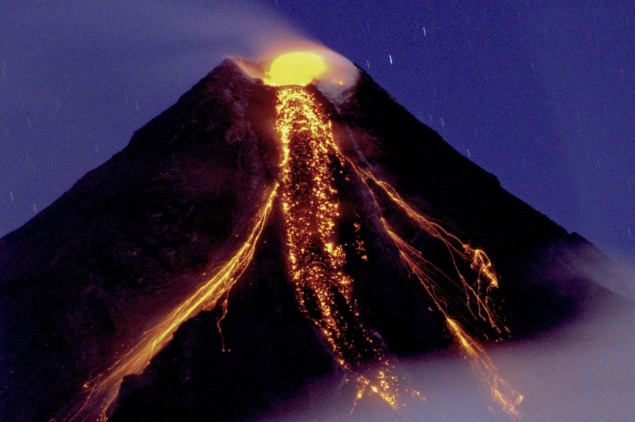
The formation of nanometre-sized crystals can – even in low concentrations – temporarily change the viscosity of magma and lead to violent volcanic eruptions. That is the conclusion of geophysicists in the UK, Germany and France, who say that their research helps to explain how otherwise calm and predictable volcanoes can turn unexpectedly explosive.
There are essentially two types of volcanic eruption: explosive and effusive. In the former, viscous molten rock with a high silica content tends to trap volcanic gases more readily. This increases the pressure on the magma column such that it can ultimately lead to an explosion. Basaltic magmas, meanwhile, have a low silica content and tend to be runnier. This usually allow gas to escape gently, leading to effusive eruptions that produce lava domes and flows of the kind seen on Hawaii.
This distinction is not clear cut, however, and basaltic magmas can sometimes unexpectedly produce explosive events. This happened at New Zealand’s Mount Tarawera in June 1886, which destroyed ten Māori settlements and killed around 120 people.
Explosive fragmentation
A common explanation for this unexpected explosivity is the growth in molten rock of microlites, which are small crystals ranging in size from 1–100 micron. In sufficient volumes, these can lock up magma flow, leading to explosive fragmentation. This occurs when magma flow switches from being a continuous liquid body containing gas and crystals to a turbulent flow dominated by gases that contain fragments of molten rock.
There is one problem with this theory, however, in that many such unexpected explosions (including Indonesia’s Mount Tambora in 1815 – the most powerful eruption in human history) occurred even though their microlite concentrations were seemingly not at a sufficiently high level of around 30% total volume.
In a new study, volcanologist Danilo Di Genova of the University of Bristol and colleagues considered the effects of nanolites, which are smaller crystals that are the precursors of microlites. Using scanning electron transmission microscopy and Raman spectroscopy, the team revealed the presence of previously-unidentified nanolites (20–50 nm in size) in ash samples from three low-viscosity eruptions: Italy’s Mount Etna (122 BC); the Colli Albani volcano (about 37,000 years ago); and Mount Tambora.
Rapid cooling
The team then created their own nanolites in the lab by melting and then cooling volcanic rock samples. Synchrotron-based X-ray spectroscopy revealed how nanolites grow under rapid cooling regimes of around 10–20 degrees per second. This cooling is typical of that experienced by magma that is ascending quickly at metres-per-second speeds. Further experiments with a synthetic magma, alongside modelling, suggest that the after-effect of so-called undercooling (where a magma, unable to solidify thanks to its dissolved water content, rapidly crystallizes once it degasses) provides the ideal scenario for nanolite growth.
Furthermore, the team found that even in low nanolite concentrations of 5% by volume, the spacing between each nanolite can be very small. “It is already accepted that even a low viscosity melt struggles to flow if it becomes locked by a network of crystals, but this usually requires a fraction of well over 30%,” Di Genova explained. “Nanolites also have a propensity to agglomerate together and form new and larger solid objects. During this process, volcanic liquid remains trapped inside these agglomerates to effectively increase the fraction of solids in the magma.”
Together, he explained, these processes account for how nanolites can increase magma viscosity for a short time as they form – leading to the previously inexplicable “sudden switch in behaviour,” that can cause calm volcanoes “to occasionally present us with a deadly surprise”.

X-rays suggest lower-mantle magma could be stabilized by heavy elements
“Nanoparticles suspended in a very low viscosity fluid appear to have a great effect increasing the bulk viscosity of the suspension even at low concentrations – a factor which could, if confirmed for magma viscosity, enhance explosivity during eruptions,” comments Francisco Cáceres, an experimental volcanologist from the Ludwig-Maximilians-University of Munich. He adds, “This work opens a window to new research that needs to be performed on natural magma, in order to test this claim”.
University of Cambridge volcanologist Marie Edmonds adds, “This work will have very important implications for our understanding of basaltic explosive eruptions but also more broadly for magma rheology, nucleation and growth of crystals and bubbles; and the strength of magma under shear. It will be important in the future to understand whether wet magmas – those containing lots of water, such as in subduction zones – behave in the same way as those in the experiments, which were dry.”
With their initial study complete, the researchers are moving to model the explosive impact of nanolites on real-life low-silica volcanic settings. When travel restrictions lift after the pandemic, they will be hunting for more examples of nanolites in volcanic rock from across the globe.
The research is described in the Science Advances.



